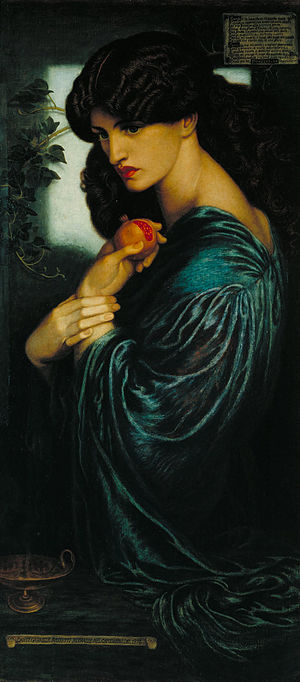Author Melanie Jackson talks about her new novel, Death Drop:
In his famous portrait of Persephone, Dante Gabriel Rossetti shows the young woman of myth having just taken a bite out of a pomegranate. Persephone’s gloomy, brooding expression conveys that she knows quite well she should have left the delicious red fruit alone. After all, she had been warned the fruit had a spell on it. Now there will be—well, Hades to pay. She’ll have to go live with the god of the underworld.
But hey, maybe it was a hot day. And bittersweet pomegranates are soooo refreshing. Who could blame Persephone?
In fact, it’s the very humanness of the portrait that appealed to me when writing my young-adult thriller Death Drop, about an amusement park ride based on Persephone’s misadventures. In the novel, one of Rossetti’s versions of the portrait is on loan to the Death Drop ride, and thieves eye it with much the same greediness as Persephone did the pomegranate.
I was intrigued by the naturalistic, haunted-looking woman in the 1874 painting. On doing research, I found out Rossetti’s model for this and other pre-Raphaelite paintings was one Jane Morris, née Burden. The daughter of a stableman and a laundress, Jane took it on herself to become literate and well-spoken so that she could move in higher-class circles. Does this sound like Eliza Doolittle? It should—George Bernard Shaw is widely reputed to have derived his Pygmalion heroine from Jane.
Jane’s husband William was a well-known designer, poet, novelist and social activist. The fact that Jane was married didn’t put Rossetti off. He was hopelessly in love with her and, from what we know, it’s doubtful Jane
felt the same. In studying Jane/Persephone, I wondered if that haunted expression held just a bit of annoyance? After all, the obsessive Rossetti plied Jane with his lovelorn attentions for years.
There’s something else to notice about the portrait. True, having eaten the pomegranate, Persephone is stuck with descending to the underworld and marrying Hades (a spouse who would not, one guesses, be a barrel of laughs). But when I viewed the portrait up close at London’s Tate Gallery, it was part of an exhibit titled Painting with Light. Note: light, as opposed to dark. Light does feature in the portrait along with the murky patches. And you might say that where there’s light there’s hope! Persephone must endure six subterranean months. But for the other six months of every year she comes back up on earth, bringing spring and harvest and happiness.
As geeky, brainy Dieter also notes in Death Drop: “‘The sunlight and shadow could also represent Dante Rossetti’s feelings for his model. He loved her but he couldn’t have her.’”


Death Drop by Melanie Jackson is available now!

